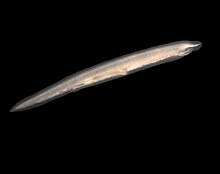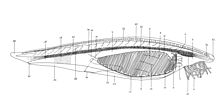Branchiostoma
| Branchiostoma | |
|---|---|

| |
| Branchiostoma lanceolatum from Belgium | |
| Scientific classification | |
| Kingdom: | |
| Phylum: | |
| Subphylum: | |
| Class: | Leptocardii
|
| Order: | |
| Family: | |
| Genus: | Branchiostoma Costa, 1834
|
| Type species | |
| Branchiostoma lanceolatum (Pallas, 1774)
| |
| Diversity | |
| About 11 species | |
| Synonyms | |
|
Amphioxus Yarrel, 1836[1] | |
Branchiostoma is one of the few living genera of lancelets (order Amphioxiformes). It is the type genus of family Branchiostomidae.

These small vaguely eel- or snake-like animals are close relatives of vertebrates. The scientific name means "gill-mouth", referring to their anatomy – unlike vertebrates, they do not have a true head (with a skull capsule, eyes, nose, a well-developed brain etc.), but merely a mouth adjacent to the gill-slits, with the slightly enlarged anterior end of the dorsal nerve cord above and in front of them.
Like all lancelets, they are filter feeders that hide in the sediment most of the time. The genus inhabits coastal waters e.g. of the North Atlantic.
Species
- Branchiostoma belcheri
- Branchiostoma californiense
- Branchiostoma capense
- Branchiostoma caribaeum
- Branchiostoma clonaseum
- Branchiostoma floridae
- Branchiostoma lanceolatum
- Branchiostoma minucauda
- Branchiostoma moretonensis
- Branchiostoma valdiviae
- Branchiostoma virginiae
Lancelet biodiversity is not very well studied; other as yet undescribed species (perhaps including cryptic species) might await discovery.
References
External links
![]() Media related to Branchiostoma at Wikimedia Commons
Media related to Branchiostoma at Wikimedia Commons
